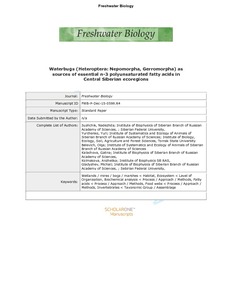Waterbugs (Heteroptera: Nepomorpha, Gerromorpha) as sources of essential n-3 polyunsaturated fatty acids in Central Siberian ecoregions
Скачать файл:
DOI:
10.1111/fwb.12818URI (для ссылок/цитирований):
https://elib.sfu-kras.ru/handle/2311/27985Автор:
Сущик, Н. Н.
Юрченко, Ю. А.
Белевич, О. Э.
Калачева, Г. С.
Колмакова, А. А.
Гладышев, М. И.
Коллективный автор:
Институт фундаментальной биологии и биотехнологии
Кафедра водных и наземных экосистем
Дата:
2016-08Журнал:
Freshwater BiologyКвартиль журнала в Scopus:
Q1Квартиль журнала в Web of Science:
Q1Библиографическое описание:
Сущик, Н. Н. Waterbugs (Heteroptera: Nepomorpha, Gerromorpha) as sources of essential n-3 polyunsaturated fatty acids in Central Siberian ecoregions [Текст] / Н. Н. Сущик, Ю. А. Юрченко, О. Э. Белевич, Г. С. Калачева, А. А. Колмакова, М. И. Гладышев // Freshwater Biology. — 2016. — Т. 61. — С. 1787-1801Аннотация:
1. Aquatic systems are considered a main source of essential long-chain n-3 polyunsaturated fatty acids (PUFA), which are preferentially synthesized by microalgae and transferred along food chains to terrestrial consumers. Emerging aquatic insects comprise a significant part of this transfer of the essential PUFA from water to land. Quantitative data on PUFA content and composition are available mainly for rheophilic insects while taxa that are characteristic of wetlands and stagnant water bodies, such as aquatic Heteroptera, remain relatively unstudied.
2. We investigated the role of various waterbug taxa (Heteroptera: Nepomorpha) inhabiting different ecoregions in temperate Central Siberia (Russia) as potential sources of PUFA. The ecoregions were steppe, forest-steppe, hemiboreal forest and montane coniferous forest. Although these waterbugs insects are aquatic in both larval and adult stages, they can disperse through the landscape and transfer essential PUFAs from water to land so making them potentially available to terrestrial consumers.
3. Species of Naucoridae, Notonectidae and Corixidae were generally dominant in all ecoregions, attaining maximum biomass in the steppe. We showed that habitat or ecoregion played a major role in the variability of fatty acid composition of Notonectidae and Gerridae but not Corixidae. In contrast, the biochemical composition of the only naucoridae, Ilyocoris cimicoides, was largely affected by life stage.
4. Both the dominant families and species within them differed with respect to their mass-specific contents of essential long-chain PUFA of the n-3 family, namely eicosapentaenoic and docosahexaenoic acids. Corixid species had the highest content of these two essential PUFAs among the waterbugs studies, and relative to literature reports for other aquatic insects. Corixids thus appear to be a potentially important vector for transfer of the essential biochemical compounds from water to land, especially in steppe ecoregions with numerous ephemeral water bodies.

